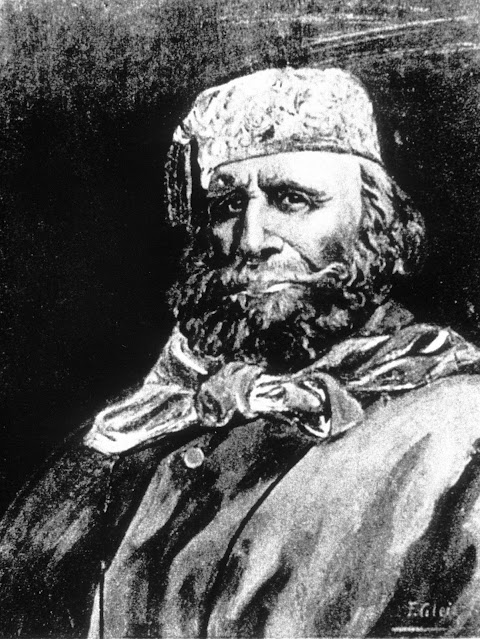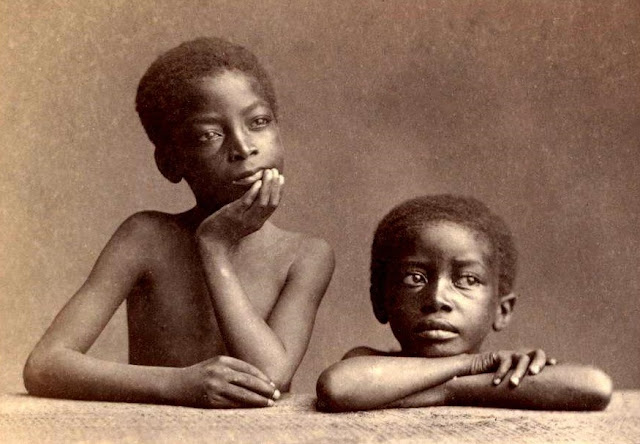The Portuguese Governor of a West African Kingdom
The European Governor of an African Empire
 |
| 2010 Reproduction of an oil painting of Francisco de Sousa (Credit: Professor and anthropologist Milton Guran) |
French ethnographer Pierre Verger (1902-1996) once called Francisco Félix de Sousa (1754-1849) the greatest slave trader of all time.
And yet, de Sousa was an adopted member of the kingdom of Dahomey and, particularly, its government.
 |
| Reproduction of an oil portrait of Francisco Félix de Sousa 1996 (Credit: Professor and anthropologist Milton Guran) |
Francisco Félix de Sousa helped to overthrow the administration of King Ghezo's predecessor. For that, the king declared that he was eternally indebted to "Dom Francisco."
Ghezo made him the chief of all trade in Dahomean territories, the majority of which was conquered from other Africans. As a result, de Sousa could take as many slaves as he wanted from the stockpile of captives taken in war and sell them to whomever he pleased. And as de Sousa was Portuguese, many of these slaves ended up in Brazil, but some went to places like Haiti.
With his monopoly on the slave trade in this region, de Sousa became a very, very wealthy man and made sure that members of his immediate family were installed in that same position after him as "Chacha," or Viceroy of Ouidah.
For example, he appointed his oldest son, Isidoro, as the second Chacha.
 |
| Reproduction of an oil portrait of Isidoro de Sousa undated (Credit: Professor and anthropologist Milton Guran) |
Another son known as "Chicou" served as Chacha III by the order of King Ghezo.
The fourth Chacha, Julião de Sousa (1832-1887), was appointed by Ghezo's successor Glele in 1880. His portrait is still displayed today beside his tomb in Ouidah, Benin.
 |
| Reproduction of the photographic portrait of Julião de Sousa undated (Credit: Professor and anthropologist Milton Guran) |
According to UNESCO's Milton Guran, who has done extensive research on the de Sousa family, Julião de Sousa was an affluent palm oil entrepreneur who actually visited Bahia, Brazil 'several times.' Based on the painting (which Guran photographed in black-and-white), Guran describes Julião as 'a fair-skinned man with fine features.' As the region of Brazil Julião saw was known for a sizable slave presence, he was quite familiar with the sight of African slaves and the legacy of his family patron in the slaving industry. 26.5% of Bahia's population in 1835 consisted of African people - 79% of whom were enslaved.
The record shows that Julião was indeed an integral part of the slave trade in Africa even after it was outlawed by Portugal in 1836. And altogether, the de Souzas were involved in illegal slave trading activities well into the 1850s.
But as powerful as they were, these transactions did not always go unpunished.
Guran tells us:
Julião held true to the family’s tradition of making money as a commercial middle-man between the king of Dahomey and Europeans in the slave trade, in this case forming the link with the Portuguese province of São Tomé and Príncipe under the guise of a putative colonization program.
However, times had changed, the political stakes were far higher, and his loyalty to these two traditions ended up costing him his life.
In 1887, Julião was charged by the court of Abomey for making deals to sell prisoners to the Portuguese at São Tomé and Príncipe without the king's approval. Julião was found guilty and executed along with all of his associates except for a brother and nephew.
But even after this episode, Dahomey, under Ghezo's successors, continued to appoint members of the de Sousa family to the office of Chacha.
 |
| Tomb of Julião de Sousa 1995 (Credit: Professor and anthropologist Milton Guran) |
Francisco Félix de Sousa, the most significant member of the de Sousa dynasty, paved their path to prosperity. When he first moved to the capital, the king had several traditional shrines constructed for his protection. The respect with which he was held by the kingdom of Dahomey is most evidenced in the legend that upon his death at the age of 94, King Ghezo held a great ceremony in his honor with two sons and 80 of his finest "Amazon" warriors in attendance. He is also said to have sent seven people to be sacrificed to commemorate the viceroy. Despite Isidoro having declined that offer, it has been attested that a few persons were still sacrificed anyways.
The Chacha remains a relevant title in modern Benin. The process for passing on the torch from one Chacha to another first requires that the de Sousa family holds a meeting to elect the next Chacha. This is important because the person in this position is not only making decisions for the kingdom but occupies that traditional role as the head of the de Sousa family.
 |
| King Agoli-Agbo Dédjahagni accompanies Honoré Julião Feliciano de Souza to the great door of the royal courtyard October 5, 1995 (Credit: Professor and anthropologist Milton Guran) |
In 1995, during the official enthronement ceremony of the new Chacha - a Black descendant of de Sousa who has since passed on - the reigning king of Abomey, Agoli-Agbo Dédjahagn, was asked by a journalist with Benin State Television if these things were true.
The friends and descendants of the close friend and sworn servant of King Ghezo have come to see the successor of King Houégbadja show kpoge. They are very numerous today and occupy one or more districts. They have come knowing their history, they have received the blessing of the king. If we could hear the voice of the king, that would be good.
This was the king's response:
What you say is true. All those who have studied in this country should know about the friendship between King Ghezo and the Chacha.
He continued:
They also know what King Ghezo and the Chacha said to each other.
This is sung and retold. If children hear the story and decide to perpetuate the tradition, that is a good thing. They are what intellectuals call a diaspora.
To resolve any matter in Ouidah today, one cannot ignore the De Souzas. If they say they will continue with the honor that their forefather had in Dahomey, they must be blessed so that they may have peace in the name of King Ghezo and the former Chachas. And Singbomey will regain its former glory. The new Chacha will unite the family and there will be peace.
The journalist wanted to make sure that the king was okay with the day's proceedings.
So he asked one last question:
They have come to show kpoge. Can it be said that it has been accepted by the king?
To which the king responded:
This question can no longer be asked. I have already said and made clear that on this day we will be with our friends of King Ghezo and everything will pass joyfully.
The business partnership between Dahomey and the de Sousas had a lasting impact on not only the west coast of Africa, but the east coast of South America.
What was the impact of this partnership on the slave trade itself?
Guran writes:
The blood oath between the future king and the Brazilian slave trader was first and foremost of a political and commercial nature, with all the social consequences that this entailed. Essentially, it meant that the whites ceased to be regarded as foreigners and were formally incorporated into the social and political compact that formed the basis of King Ghezo’s kingdom, taking a prominent role in his power stratagems.
It was thanks to this understanding that King Ghezo assigned Dom Francisco the rights to lands in Ouidah and other provinces of the kingdom, even though officially such rights were not permitted to foreigners. This proved fundamentally important for the permanent settlement of whites and the formation of a Brazilian community along the Slave Coast.
In her studies on this subject, Howard historian Ana Lucia Araujo uncovered a narrative replete with treachery on all sides.
The various accounts I collected during my interviews indicates that the history of Francisco Félix de Sousa's family includes betrayal of each other, and collaboration with the Europeans in exchange for political power.
While the family of Francisco Félix de Sousa became thoroughly "Africanized" over time, they disseminated European religion and culture in turn. In the canonization of local folklore, Francisco himself, she says, 'became a perfect African chief.' It was not until after the decolonization of Benin that the name of the de Sousas truly began to lose prominence in Beninese society.
De Sousa kept a harem and fathered many children with African women (numbered at just over 200 in total). Yet, he was known in contemporary accounts as a benevolent master and a self-proclaimed philanthropist. He is remembered today in like manner by those of his relation.
In the midst of these uncanny relations between foreigners and fugitives, there was at least one silver lining.
Guran notes that the colonization of Benin by Brazilian slave traders made it possible for thousands of Afro-Brazilians, many of whom were former slaves, to return to the motherland. One of the foremost persons to help facilitate that process was none other than Francisco Félix de Sousa.
- Omri C.
All photographs displayed here were taken by Milton Guran at the de Sousa family compound of Singbomey located within a Brazilian neighborhood in Ouidah, Benin.
You can read more about the relations between European traders and West African monarchs during the Trans-Atlantic slave trade here.





Comments
Post a Comment